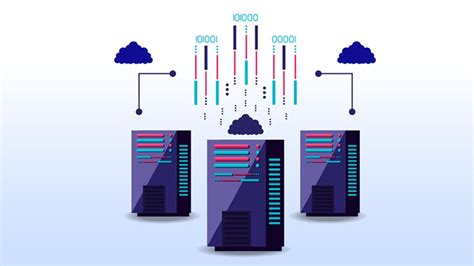In an increasingly digital world, the demand for high-performance web applications is on the rise. As users expect instant access to information and seamless experiences, developers face the challenge of ensuring their applications can handle heavy loads and traffic spikes. This is where the concept of web application load balancing comes into play.
Load balancing is a vital technique that distributes incoming traffic across multiple resources, such as servers or containers, in order to optimize performance, prevent bottlenecks, and ensure high availability. It's like juggling multiple balls in the air, constantly assessing which resource can handle the next request most efficiently.
However, when it comes to implementing load balancing in a Windows Docker environment, developers often find themselves in uncharted territory. This comprehensive guide aims to demystify the complexities of web application load balancing in the Windows Docker ecosystem, offering insights, best practices, and step-by-step instructions to achieve scalability and maximize the potential of your web applications.
Understanding the Fundamentals of Distributing Workloads Across Web Applications

In this section, we will explore the essential concepts behind efficiently distributing workloads across multiple instances of web applications. Load balancing, also known as workload distribution, plays a crucial role in optimizing performance and ensuring high availability for web applications.
Load balancing involves the process of evenly distributing incoming network traffic and requests across multiple application instances or servers. The goal is to prevent any single instance from becoming overwhelmed with excessive traffic, thereby minimizing response times and improving overall system stability.
To achieve load balancing, various techniques and algorithms are used to intelligently route requests. These include round-robin, least connections, IP hash, and weighted round-robin algorithms, among others. Each algorithm has its unique advantages and considerations, depending on the specific requirements of the web application.
| Algorithm | Description |
|---|---|
| Round-robin | Distributes requests evenly in a sequential order to each server in a rotation. |
| Least connections | Routes requests to the server with the fewest active connections at the time of the request. |
| IP hash | Uses the client's IP address to determine which server should handle the request, ensuring consistency for subsequent requests from the same IP. |
| Weighted round-robin | Assigns a weight to each server, allowing for proportional distribution of requests based on server capacity. |
Load balancing can be implemented at different layers of the network stack, including the application layer, transport layer, and DNS layer. Each approach offers its own advantages and considerations in terms of flexibility, scalability, and ease of deployment.
By understanding the basics of load balancing and considering the specific requirements of web applications, developers and system administrators can make informed decisions when designing and implementing load balancing strategies. This enables them to maximize performance, improve fault tolerance, and deliver a better user experience for web applications.
Benefits of Employing Windows Docker for Web Application Load Distribution
When considering the optimization of web application load distribution, it is essential to explore the advantages of utilizing Windows Docker. Employing a containerization platform like Windows Docker can substantially enhance the scalability, efficiency, and security of your application's load balancing process.
One notable benefit of Windows Docker in web application load distribution is the ability to seamlessly manage and orchestrate multiple instances of your application across a cluster of servers. With Docker's lightweight and isolated containers, you can easily scale your web application horizontally, ensuring optimal resource utilization and load distribution.
Furthermore, by utilizing Windows Docker, you can take advantage of the inherent benefits of containerization, such as improved deployment speed and ease of management. Docker enables the encapsulation of your application and its dependencies into portable containers, allowing for straightforward deployment on any Windows server environment without the need for complex installation processes.
Windows Docker also offers enhanced security measures for your web application load balancing. Each container operates in isolation, providing an additional layer of protection for your application and its sensitive data. By isolating individual components of your application within separate containers, you reduce the risk of potential security breaches that could affect other components.
Additionally, Windows Docker provides a highly flexible and scalable environment for load balancing. With Docker's containerization technology, you can easily add or remove instances of your application based on demand, ensuring seamless scaling and efficient resource utilization.
In summary, utilizing Windows Docker for web application load distribution brings numerous benefits to enhance the scalability, efficiency, and security of your application. From seamless management and orchestration to improved deployment speed and security measures, Windows Docker offers a comprehensive solution for effective load balancing in web applications.
Implementing Load Balancing with Windows Docker: Step-by-Step Guide

In this section, we will explore a comprehensive step-by-step approach to implementing load balancing with Windows Docker. We will guide you through the necessary steps and provide detailed instructions, allowing you to effectively distribute incoming network traffic across multiple Docker containers running on Windows servers.
- Understanding Load Balancing
- Setting up a Windows Docker Environment
- Installing Docker on Windows Servers
- Configuring Docker Networking
- Building Docker Images
- Running Docker Containers
- Choosing a Load Balancer
- Setting up Load Balancer Rules
- Verifying Load Balancing Functionality
- Monitoring Load Balancer Performance
- Scaling Docker Containers
- Performing Maintenance Tasks
By following this step-by-step guide, you will gain a comprehensive understanding of how to efficiently implement load balancing with Windows Docker. This knowledge will enable you to achieve improved scalability, reliability, and performance for your web applications.
Troubleshooting Common Issues in Web Application Load Balancing with Windows Docker
In this section, we will discuss some of the common issues that can arise when implementing web application load balancing with Windows Docker. By understanding these issues and their potential solutions, you will be better equipped to troubleshoot and resolve any problems that may occur.
- Connectivity Issues: One of the most common problems in web application load balancing is related to connectivity. This can include issues with network configuration, DNS resolution, or firewall settings. To troubleshoot connectivity issues, it is important to check the network settings, verify proper DNS resolution, and ensure that firewall rules are properly configured to allow traffic between the load balancer and the application instances.
- Load Distribution Imbalance: Another common issue is when the load balancer is not evenly distributing the incoming traffic among the application instances. This can lead to some instances being overwhelmed while others are underutilized. To troubleshoot load distribution imbalance, it is important to check the load balancer settings and configuration. Adjusting load balancing algorithms or adding additional application instances may be necessary to achieve an optimal distribution of traffic.
- Health Check Failures: Web application load balancing typically relies on health checks to determine the availability and responsiveness of application instances. If health checks fail, the load balancer may continue to send traffic to a non-functioning instance, leading to service disruptions. To troubleshoot health check failures, it is important to review the health check settings and configuration. Verifying that the application instances are properly configured and responding to health checks can help identify and resolve any issues.
- SSL Certificate Issues: When using SSL certificates in web application load balancing, certificate mismatches or expired certificates can cause connectivity issues or security warnings for users. To troubleshoot SSL certificate issues, it is important to ensure that the certificates are properly installed and configured on the load balancer and application instances. Verifying certificate validity and compatibility can help identify any certificate-related problems.
- Performance Bottlenecks: In some cases, web application load balancing may encounter performance bottlenecks, resulting in slower response times or degraded application performance. To troubleshoot performance bottlenecks, it is important to analyze system resource usage, such as CPU, memory, and disk I/O, on both the load balancer and application instances. Identifying and resolving any resource constraints or inefficiencies can help improve overall performance.
By addressing these common issues and implementing the appropriate solutions, you can ensure the smooth and efficient operation of your web application load balancing with Windows Docker setup.
What is a Load Balancer?
What is a Load Balancer? by IBM Technology 210,621 views 2 years ago 8 minutes, 22 seconds
Install Docker on Windows Server 2022 Complete Tutorial - Build your own Custom IIS Container!
Install Docker on Windows Server 2022 Complete Tutorial - Build your own Custom IIS Container! by VirtualizationHowto 36,139 views 1 year ago 12 minutes, 54 seconds
FAQ
What is web application load balancing in Windows Docker?
Web application load balancing in Windows Docker is the process of evenly distributing incoming network traffic across multiple containers or instances of a web application running on Docker. It helps to improve scalability, availability, and performance by ensuring that no single container or instance is overwhelmed with requests.
Why is load balancing important for web applications?
Load balancing is important for web applications because it helps to distribute incoming network traffic efficiently and prevent any single component from becoming a bottleneck. By evenly distributing the load across multiple containers or instances, load balancing improves scalability, reliability, and responsiveness of the web application.
How does web application load balancing work in Windows Docker?
In Windows Docker, web application load balancing is achieved through the use of a load balancer that sits in front of the containerized web application instances. The load balancer routes incoming requests to the different instances based on predefined algorithms or rules, such as round robin or least connections. This ensures that the workload is evenly distributed and helps to optimize resource usage within the Docker environment.




